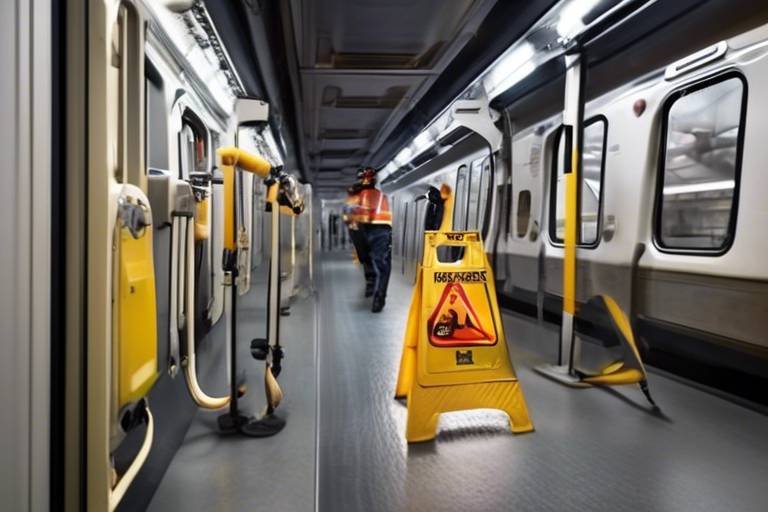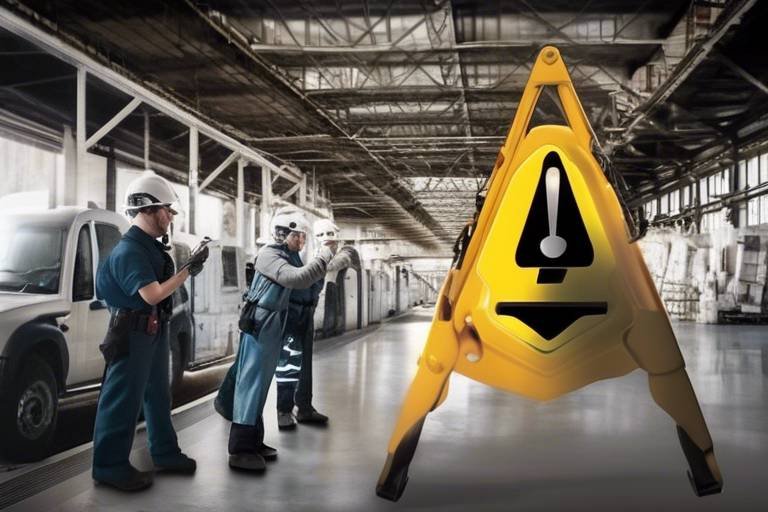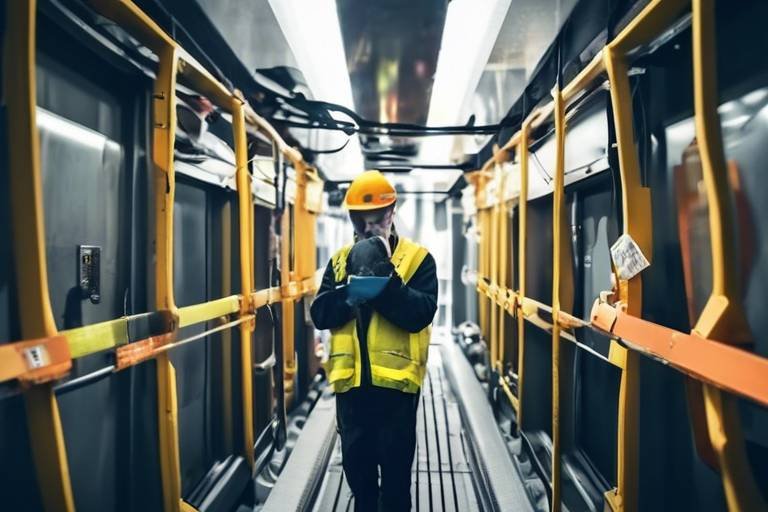The Definitive Connection between Human Behavior and Safety Measures
In today's fast-paced world, understanding the intricate relationship between human behavior and safety measures is crucial for creating effective safety protocols across various environments. The way individuals perceive and respond to safety practices can significantly influence the overall safety culture within an organization. It's fascinating to consider how our actions, decisions, and even emotions can dictate the effectiveness of safety measures. For instance, think about how a simple safety sign can either be ignored or embraced, depending on the mindset of those who see it. This article will delve deep into the psychological and social factors that shape human behavior, revealing how they intertwine with safety protocols and compliance.
When we talk about safety, we often think of rules and regulations, but at the heart of it all lies human behavior. Why do some people adhere strictly to safety guidelines while others flout them? The answer often lies in their understanding, training, and the environment they are in. For example, if employees feel that safety measures are merely a formality, they are less likely to take them seriously. Conversely, if they understand the reasons behind these measures and see their importance, compliance tends to increase. This relationship is akin to a dance; both partners must be in sync for the performance to be successful.
Moreover, the role of training cannot be overstated. Effective training programs are not just about transferring knowledge; they are about instilling a culture of safety within an organization. By examining the psychological aspects of how individuals learn and adapt, we can tailor training programs that resonate with employees, making safety not just a priority but a core value. This approach is like planting a seed; with the right care and attention, it can grow into a robust culture of safety that flourishes over time.
As we explore the connection between human behavior and safety measures, it becomes clear that this relationship is essential for any organization aiming for a safe working environment. By understanding the factors that influence behavior, implementing effective training, and continually assessing compliance, organizations can create a safety culture that not only protects employees but also enhances productivity and morale. The journey towards safety is ongoing, and by fostering a deeper understanding of human behavior, we can pave the way for a safer future.
- What is the importance of understanding human behavior in safety measures?
Understanding human behavior helps organizations tailor safety protocols that resonate with employees, leading to better compliance and a safer workplace. - How can training improve safety compliance?
Effective training instills safety behaviors and knowledge, making employees more likely to adhere to safety protocols. - What are behavioral safety programs?
These programs focus on changing individual behaviors to enhance safety outcomes, emphasizing the importance of personal responsibility in maintaining a safe environment. - What is the future of safety measures?
The future of safety measures will likely incorporate emerging technologies and innovative practices to further enhance workplace safety.

Understanding Human Behavior
When we delve into the world of human behavior, we uncover a complex web of psychological and social factors that shape how individuals react to various situations, especially when it comes to safety measures. Imagine a bustling workplace where safety protocols are in place, yet compliance varies widely among employees. Why does this happen? Understanding the underlying motivations and emotions driving human behavior can provide crucial insights into this phenomenon.
At the heart of human behavior lies the concept of perception. How we perceive risks and safety measures can significantly influence our actions. For instance, an employee who views a safety protocol as unnecessary may be less likely to comply with it. On the other hand, if they perceive the same protocol as essential for their well-being, compliance is likely to increase. This perception is often shaped by past experiences, cultural influences, and even the attitudes of peers.
Moreover, social dynamics play a pivotal role in shaping behavior. Humans are inherently social creatures, and our behaviors are often influenced by those around us. If a team leader consistently emphasizes the importance of safety and models compliant behavior, team members are more likely to adopt similar attitudes. Conversely, if safety measures are disregarded by influential figures within a group, others may follow suit, leading to a culture of non-compliance. This phenomenon highlights the importance of leadership in promoting a safety-first mindset.
Furthermore, emotional factors cannot be overlooked. Fear, anxiety, and stress can cloud judgment and lead to risky behaviors. For example, an employee who is overwhelmed by deadlines may prioritize getting the job done over adhering to safety protocols, believing they don't have the time to follow them. Addressing these emotional aspects through support systems and open communication can foster a safer work environment.
To truly grasp the connection between human behavior and safety measures, organizations must invest in understanding their workforce. This involves not only implementing safety protocols but also engaging in active listening and gathering feedback. By doing so, companies can tailor their safety measures to align with the actual behaviors and attitudes of their employees.
In summary, understanding human behavior is not just about observing actions; it's about diving deep into the motivations, perceptions, and emotions that drive those actions. By recognizing these elements, organizations can develop more effective safety measures that resonate with their employees, ultimately leading to a safer workplace.

The Role of Training in Safety Compliance
When it comes to safety in the workplace, the phrase "knowledge is power" holds a significant amount of truth. Effective training programs are not just a box to check; they are the backbone of safety compliance. Imagine a ship setting sail without a map or compass—without training, employees may find themselves lost in a sea of safety protocols, unsure of how to navigate potential hazards. Training equips individuals with the necessary skills and knowledge to recognize risks and respond appropriately, ultimately fostering a culture of safety.
But why is training so crucial? Well, it’s all about behavioral change. When employees understand the 'why' behind safety measures, they are more likely to embrace these practices. For instance, a construction worker who knows the dangers of not wearing a hard hat is more likely to comply when they understand that it could save their life. This psychological shift from viewing safety measures as mere rules to seeing them as essential practices is what training aims to achieve.
Moreover, training isn’t a one-time event; it’s an ongoing process. Just like any skill, safety knowledge requires regular reinforcement. Organizations that invest in continuous training programs often see a marked improvement in compliance rates. For example, companies that implement refresher courses or regular safety drills tend to have fewer workplace incidents. This leads to not only a safer environment but also boosts employee morale and confidence.
Let's break down the impact of training on safety compliance into a few key areas:
- Retention of Safety Knowledge: Regular training helps reinforce safety knowledge, ensuring that employees remember crucial protocols.
- Adaptability to New Procedures: As safety regulations evolve, ongoing training allows employees to stay updated and adaptable.
- Increased Engagement: Interactive training sessions can turn passive learning into active participation, making employees more engaged and likely to comply.
Now, let’s take a closer look at the types of training methodologies that can enhance safety compliance:
| Type of Training | Description | Benefits |
|---|---|---|
| Hands-On Training | Active participation in safety drills and scenarios. | Enhances retention and real-world application. |
| Online Modules | Self-paced learning through digital platforms. | Offers flexibility and accessibility. |
| Workshops | In-person sessions focusing on specific safety topics. | Encourages collaboration and discussion. |
In conclusion, the role of training in safety compliance cannot be overstated. It is about creating a proactive culture where safety is prioritized, and employees feel empowered to act responsibly. As organizations continue to evolve, so too should their training programs, ensuring that they meet the needs of their workforce. By investing in comprehensive training, companies not only comply with regulations but also create a safer, more productive environment for everyone.
Q1: How often should safety training be conducted?
A1: Safety training should be conducted regularly, with refresher courses at least annually, and more frequently for high-risk industries.
Q2: What are the signs of effective safety training?
A2: Effective safety training results in improved compliance rates, increased employee engagement, and a noticeable decline in workplace incidents.
Q3: Can online training be as effective as in-person training?
A3: Yes, when designed well, online training can be highly effective due to its flexibility and ability to cater to different learning styles.

Types of Safety Training
When it comes to ensuring a safe work environment, effective training is key. But did you know that not all training is created equal? Different types of safety training cater to various learning styles, which is crucial for achieving maximum compliance and understanding among employees. Think of it like cooking; just as you wouldn't use the same recipe for every dish, you shouldn't use the same training method for every employee. By diversifying training approaches, organizations can better engage their workforce and enhance safety awareness.
One of the most common types of safety training is hands-on training. This method allows participants to actively engage with the material, practicing safety measures in real-life scenarios. Imagine learning to ride a bike only by reading about it; you’d likely struggle when it came time to actually ride! Hands-on training provides employees with the opportunity to practice safety protocols, which enhances retention and builds confidence. For example, a construction company might set up a mock site where workers can practice using safety equipment like harnesses and helmets.
On the flip side, we have online safety training modules. These digital platforms offer flexibility and accessibility, allowing employees to learn at their own pace. This is especially beneficial for those who may have varying schedules or prefer to absorb information in a quieter environment. Online training can include interactive quizzes, videos, and even virtual simulations that mimic real-life situations. However, while this method is convenient, it’s essential to ensure that it remains engaging and not just a monotonous series of slides. Combining multimedia elements can keep learners interested and focused.
Moreover, organizations can also implement a blended approach, combining both hands-on and online training. This hybrid model can cater to a wider audience, ensuring that everyone from seasoned employees to newcomers can grasp essential safety protocols. By offering multiple formats, companies can address different learning preferences, making it easier for everyone to comply with safety measures.
In summary, the type of safety training implemented can significantly impact the effectiveness of safety protocols in the workplace. By understanding the various methods available—be it hands-on, online, or a blended approach—organizations can create a comprehensive training program that not only informs but also engages employees. After all, when it comes to safety, knowledge is power, and the more empowered employees feel, the safer the workplace becomes.

Hands-On Training Techniques
When it comes to ensuring safety in the workplace, are like the secret sauce that brings everything together. Imagine trying to learn how to ride a bike just by reading a manual. It’s nearly impossible, right? The same principle applies to safety training. Engaging participants through practical experiences allows them to internalize safety protocols in a way that theory alone simply cannot achieve. By actively participating in safety drills and simulations, employees can see firsthand how their actions impact their safety and the safety of others.
One of the most effective methods of hands-on training is through simulated scenarios. These can range from emergency evacuations to equipment handling. Participants are placed in realistic situations where they must apply their knowledge and skills. This not only boosts their confidence but also helps them to understand the gravity of safety measures. For instance, during a fire drill, employees experience the urgency of evacuation in a controlled environment, allowing them to grasp the importance of quick decision-making.
Moreover, hands-on techniques often incorporate peer-to-peer learning. When employees train each other, it fosters a sense of camaraderie and accountability. They learn from each other’s experiences and mistakes, which can be incredibly valuable. This method not only reinforces safety knowledge but also builds a strong safety culture within the organization. The more employees feel connected and engaged, the more likely they are to adhere to safety protocols.
Another component of hands-on training is the use of interactive tools and technology. Virtual reality (VR) and augmented reality (AR) are becoming increasingly popular in safety training. These technologies allow employees to immerse themselves in a virtual environment where they can practice safety measures without real-world consequences. For example, a VR simulation of a hazardous work environment can prepare employees for the challenges they might face on the job, ensuring they are well-equipped to handle potential dangers.
To summarize, hands-on training techniques are not just beneficial; they are essential for effective safety compliance. By engaging employees through practical experiences, fostering peer learning, and utilizing cutting-edge technology, organizations can create a robust safety training program that not only educates but also empowers employees to prioritize safety in their daily operations.
- What is hands-on training? Hands-on training involves practical, interactive learning experiences that allow participants to apply their knowledge in real-world scenarios.
- Why is hands-on training important for safety? It enhances retention of safety protocols, boosts confidence, and helps employees understand the real-life implications of their actions.
- How can technology be integrated into hands-on training? Technologies like virtual reality and augmented reality can simulate hazardous environments, allowing employees to practice safety measures without risk.
- What are some examples of hands-on training techniques? Examples include simulated emergency drills, peer-to-peer learning sessions, and the use of interactive safety tools.

Online Safety Training Modules
In today’s fast-paced world, the need for effective safety training is more crucial than ever. have emerged as a game-changer, providing a flexible and accessible way for employees to engage with safety protocols. Imagine being able to learn about safety measures from the comfort of your own home or during a break at work. This convenience not only saves time but also allows individuals to absorb information at their own pace, leading to better retention and understanding.
One of the significant advantages of online training is its ability to cater to various learning styles. For instance, visual learners benefit from videos and infographics, while auditory learners can engage with podcasts or recorded lectures. This diversity in teaching methods ensures that every employee can grasp essential safety concepts, regardless of their preferred learning style. Moreover, interactive elements such as quizzes and simulations can enhance engagement, making the learning experience more enjoyable and effective.
Many organizations have reported a marked improvement in safety compliance after implementing online training modules. The statistics speak for themselves: companies that have transitioned to digital training platforms have seen a 30% increase in knowledge retention and a 25% reduction in workplace incidents. These numbers highlight the undeniable impact that well-structured online training can have on fostering a culture of safety within the workplace.
However, it’s essential to understand that not all online training programs are created equal. The effectiveness of a module depends on its content quality, user interface, and the ability to engage participants. A well-designed module should include:
- Clear objectives: Employees should know what they are expected to learn.
- Engaging content: Use real-life scenarios and interactive elements to keep learners interested.
- Assessment tools: Quizzes and tests to evaluate understanding and retention.
- Accessibility: Ensure that the training is available on multiple devices for ease of access.
As technology continues to evolve, the future of online safety training looks promising. Innovations such as virtual reality (VR) and augmented reality (AR) are beginning to make their way into training programs, providing immersive learning experiences that can simulate real-life situations. This not only enhances understanding but also prepares employees to respond effectively in emergencies.
In conclusion, online safety training modules represent a significant advancement in how we approach workplace safety. By leveraging technology, organizations can create a more informed workforce that prioritizes safety. As we continue to embrace these digital solutions, the potential for improved safety outcomes is limitless.
1. What are online safety training modules?
Online safety training modules are digital programs designed to educate employees about safety protocols and procedures in a flexible and accessible format.
2. How do online training modules improve safety compliance?
They provide engaging, interactive content that caters to various learning styles, leading to better retention and understanding of safety measures.
3. Can online training be as effective as in-person training?
Yes, studies show that online training can lead to equal or even superior outcomes compared to traditional in-person training, particularly when well-designed.
4. What technologies are being incorporated into online safety training?
Emerging technologies such as virtual reality (VR) and augmented reality (AR) are being integrated to create immersive learning experiences.
5. How can I ensure the effectiveness of online safety training?
Choose programs with clear objectives, engaging content, assessment tools, and accessibility across multiple devices to maximize effectiveness.

Measuring Safety Compliance
Measuring safety compliance is not just a box-ticking exercise; it’s a vital step in ensuring that safety measures are effective and that employees are genuinely adhering to protocols. The importance of this measurement cannot be overstated, as it serves as a reflection of an organization’s commitment to maintaining a safe work environment. Think of it as a health check for your safety culture—if you don’t measure it, how can you improve it?
To effectively gauge safety compliance, organizations can employ a variety of methods. One common approach is through regular audits and inspections. These can be scheduled or surprise visits, allowing safety officers to observe behaviors and practices in real-time. Additionally, organizations often utilize self-assessment checklists, enabling employees to evaluate their own adherence to safety protocols. This method not only promotes accountability but also encourages a culture of safety awareness.
Another critical aspect of measuring compliance is the collection and analysis of incident reports. By examining near misses and accidents, organizations can identify patterns and areas for improvement. For instance, if a specific safety protocol is frequently violated, it may indicate a need for additional training or a revision of the procedure itself. The data gathered can be compiled into a compliance dashboard, providing a visual representation of safety performance over time.
| Method of Measurement | Description | Benefits |
|---|---|---|
| Audits and Inspections | Regular checks to observe compliance in real-time. | Immediate feedback and identification of unsafe practices. |
| Self-Assessment Checklists | Employee-led evaluations of their adherence to safety protocols. | Promotes accountability and self-awareness. |
| Incident Report Analysis | Reviewing reports of accidents and near misses. | Identifies trends and areas for improvement. |
Furthermore, employee feedback plays a crucial role in measuring safety compliance. Conducting surveys or focus groups can provide insights into how employees perceive safety measures and their willingness to comply. This qualitative data can be just as valuable as quantitative metrics, as it sheds light on the underlying attitudes and beliefs that drive behavior.
In conclusion, measuring safety compliance is a multifaceted process that requires a combination of quantitative and qualitative methods. By employing a robust measurement strategy, organizations can ensure that safety protocols are not only in place but are also effective in fostering a culture of safety. After all, a safe workplace is a productive workplace, and understanding compliance is the first step in achieving that goal.
- What is safety compliance? Safety compliance refers to the adherence to safety regulations and protocols within a workplace to ensure the well-being of employees.
- Why is measuring safety compliance important? Measuring safety compliance helps organizations identify gaps in safety practices, improve training programs, and ultimately reduce workplace incidents.
- What methods can be used to measure safety compliance? Common methods include audits, self-assessment checklists, incident report analysis, and employee feedback.
- How often should safety compliance be measured? Safety compliance should be measured regularly, with audits and assessments conducted at least annually, or more frequently depending on the nature of the workplace.

Behavioral Safety Programs
Behavioral safety programs are integral to fostering a culture of safety within organizations. These programs focus on the psychological aspects of human behavior, aiming to change how individuals perceive and respond to safety protocols. By understanding the motivations behind actions, organizations can effectively tailor their safety measures to encourage compliance and reduce incidents. But what exactly makes these programs tick? Let's dive deeper.
At the core of behavioral safety programs is the belief that most workplace incidents are preventable and that changing behavior is key to enhancing safety. These programs typically involve a structured approach that includes observation, feedback, and reinforcement. Employees are not just passive recipients of safety information; they are active participants in the safety culture. This engagement creates a sense of ownership over safety practices, leading to more conscientious behavior.
One of the most compelling aspects of behavioral safety programs is their reliance on data-driven insights. Organizations collect data on safety behaviors through observations and incident reports. This data is then analyzed to identify patterns and areas for improvement. By sharing these insights with employees, organizations can highlight the importance of safe behaviors and motivate staff to adopt them. For instance, a company might notice a higher rate of near-misses during specific shifts or tasks, prompting targeted training or interventions.
| Component | Description |
|---|---|
| Observation | Regularly monitoring employees to identify unsafe behaviors and practices. |
| Feedback | Providing constructive feedback to employees about their safety practices. |
| Reinforcement | Recognizing and rewarding safe behaviors to encourage continued compliance. |
To illustrate the effectiveness of behavioral safety programs, consider the example of a manufacturing plant that implemented such a program. By focusing on employee behaviors, the plant saw a dramatic reduction in accidents—down by over 50% within a year. This success was attributed to the active involvement of employees in safety discussions, the implementation of peer observations, and the use of positive reinforcement strategies.
Moreover, the impact of these programs extends beyond just reducing incidents. They foster a culture of trust and communication within the workplace. When employees feel valued and heard, they are more likely to report unsafe conditions or behaviors without fear of retribution. This open line of communication is crucial for continuous improvement in safety practices.
In conclusion, behavioral safety programs are not just about compliance; they are about creating a proactive safety culture that empowers employees to take charge of their own safety and that of their colleagues. As organizations continue to evolve, so too must their approach to safety. By investing in behavioral safety programs, companies can create a safer, more engaged workforce that prioritizes well-being above all.
- What are behavioral safety programs?
Behavioral safety programs are initiatives designed to change employee behaviors to improve safety outcomes in the workplace. - How do these programs work?
They typically involve observation, feedback, and reinforcement strategies to encourage safe behaviors among employees. - What are the benefits of implementing such programs?
Benefits include reduced workplace incidents, increased employee engagement, and improved communication regarding safety practices.

Key Components of Behavioral Safety
Behavioral safety is not just a buzzword; it’s a transformative approach that focuses on the human element of safety in the workplace. By understanding and modifying behaviors, organizations can significantly reduce incidents and improve overall safety culture. The key components of behavioral safety programs include:
- Observation and Feedback: Regular observation of employees' behaviors is crucial. This includes identifying unsafe practices and providing immediate feedback. It’s like having a coach by your side, guiding you to perform better.
- Employee Involvement: Engaging employees in safety discussions and decision-making processes fosters a sense of ownership. When individuals feel they have a stake in safety, they are more likely to adhere to protocols.
- Positive Reinforcement: Recognizing and rewarding safe behaviors can motivate employees to maintain those behaviors. Think of it as a pat on the back that encourages individuals to keep up the good work.
- Continuous Improvement: Behavioral safety is not a one-time effort; it requires ongoing assessment and adjustment. Organizations should regularly evaluate their safety programs and make necessary changes based on feedback and incident reports.
These components work together to create a robust behavioral safety framework. For instance, when employees are actively involved in safety initiatives, they become more aware of their surroundings and potential hazards. This awareness is further enhanced by consistent observation and feedback, which helps to instill safe practices as second nature.
Moreover, positive reinforcement plays a vital role in this ecosystem. When employees receive recognition for safe behaviors, it creates a culture of safety where individuals are encouraged to look out for one another. It’s akin to a team sport where everyone plays their part to achieve a common goal—safety.
In addition to these components, it is essential to incorporate training and education into the behavioral safety program. Training equips employees with the knowledge they need to identify risks and respond appropriately. This combination of knowledge and behavioral modification leads to a safer work environment.
To illustrate the impact of these components, consider a manufacturing plant that implemented a behavioral safety program focusing on observation and feedback. Over six months, they observed a 40% reduction in workplace incidents. This success was attributed to the active involvement of employees in the safety processes and the positive reinforcement of safe practices. Such results highlight the effectiveness of a well-structured behavioral safety program.
Ultimately, the key to successful behavioral safety lies in understanding that safety is a shared responsibility. By focusing on these components, organizations can create a culture where safety is prioritized, leading to a significant reduction in incidents and a more engaged workforce.
Q1: What is behavioral safety?
A1: Behavioral safety focuses on modifying individual behaviors to enhance safety outcomes in the workplace. It involves observation, feedback, and employee involvement to create a safer environment.
Q2: How can I implement a behavioral safety program?
A2: To implement a behavioral safety program, start by engaging employees in safety discussions, observing their behaviors, providing feedback, and recognizing safe practices. Continuous assessment and improvement are also crucial.
Q3: What benefits can I expect from a behavioral safety program?
A3: Organizations can expect reduced workplace incidents, improved safety culture, and increased employee engagement from a well-implemented behavioral safety program.
Q4: How often should I evaluate my behavioral safety program?
A4: Regular evaluations are essential. Aim to assess the program at least quarterly to identify areas for improvement and ensure its effectiveness.

Success Stories in Behavioral Safety
When it comes to implementing behavioral safety programs, the proof is often in the pudding. Organizations that have successfully adopted these programs showcase not just compliance, but a genuine transformation in workplace safety culture. Let's dive into some inspiring success stories that highlight the effectiveness of these initiatives.
One remarkable example comes from a large manufacturing company that faced a staggering number of workplace accidents. After introducing a comprehensive behavioral safety program, they managed to reduce incidents by over 50% within just one year. This was achieved through a combination of engaging employees in safety discussions, conducting regular safety audits, and recognizing safe behaviors through a rewards system. Employees felt empowered, and the culture shifted from one of compliance to one of active participation.
Another success story can be found in the construction industry, where safety is paramount. A construction firm implemented a behavioral safety program that emphasized peer-to-peer observations. Workers were encouraged to observe and report unsafe behaviors among their colleagues. This initiative not only fostered a sense of accountability but also built camaraderie among the workforce. As a result, the company reported a 30% decrease in near-miss incidents and a significant improvement in overall safety morale.
These stories are not just isolated incidents; they illustrate a broader trend where organizations are recognizing the importance of understanding human behavior in enhancing safety protocols. By focusing on behavioral changes rather than just compliance, companies are seeing tangible results. Here are some key takeaways from these success stories:
- Empowerment: Employees who feel involved in safety discussions are more likely to adhere to safety protocols.
- Peer Accountability: Encouraging workers to observe one another fosters a culture of safety.
- Recognition: Rewarding safe behaviors reinforces positive actions and encourages others to follow suit.
In addition to these examples, many organizations have also utilized data analytics to track the effectiveness of their behavioral safety programs. By analyzing incident reports and employee feedback, they can continuously refine their approaches and ensure that safety remains a top priority. The results speak for themselves: companies that invest in behavioral safety not only protect their employees but also enhance productivity and morale.
As we look to the future, the importance of these success stories cannot be overstated. They serve as a reminder that when organizations prioritize understanding human behavior and implement effective strategies, they can create safer work environments that benefit everyone involved.
Q: What is behavioral safety?
A: Behavioral safety focuses on identifying and changing unsafe behaviors to improve workplace safety outcomes.
Q: How can organizations implement behavioral safety programs?
A: Organizations can implement these programs through training, peer observations, and creating a culture of safety where employees feel empowered to speak up.
Q: What are the benefits of behavioral safety programs?
A: Benefits include reduced workplace incidents, improved employee morale, and enhanced compliance with safety protocols.

The Future of Safety Measures
As we step into an era defined by rapid technological advancements and evolving workplace dynamics, it’s crucial to understand that the future of safety measures will not only rely on traditional protocols but will also embrace innovative solutions. Just like a river that adapts its course to the landscape, safety measures must continuously evolve to meet the changing needs of industries and their workforce. This evolution is driven by factors such as artificial intelligence, data analytics, and an increased focus on mental health.
One of the most exciting developments is the integration of artificial intelligence (AI) into safety protocols. Imagine a workplace where AI monitors real-time data, predicting potential hazards before they occur. For instance, AI algorithms can analyze patterns in employee behavior and environmental conditions, thereby alerting management of risks before they escalate. This proactive approach not only enhances safety but also fosters a culture of prevention. Companies that leverage AI are likely to see a significant reduction in workplace incidents, akin to having a vigilant guardian watching over employees at all times.
Moreover, data analytics plays a pivotal role in shaping safety measures. By collecting and analyzing large volumes of data, organizations can identify trends and pinpoint areas that require immediate attention. For example, if a particular department experiences a higher rate of accidents, management can delve into the data to uncover the underlying causes. This data-driven approach allows for targeted interventions, ensuring that resources are allocated efficiently and effectively, much like a surgeon using precise tools to address a specific ailment.
Another key aspect of the future of safety measures is the emphasis on mental health. As workplaces become more dynamic and demanding, the psychological well-being of employees has taken center stage. Organizations are beginning to recognize that a mentally healthy workforce is a safer workforce. Initiatives that promote mental well-being, such as stress management workshops and open communication channels, are essential. By fostering an environment where employees feel supported, organizations can reduce the likelihood of accidents caused by stress or burnout.
Furthermore, the rise of remote work has introduced new challenges and opportunities in safety measures. Companies must adapt their safety protocols to encompass remote employees, ensuring they have the necessary tools and resources to maintain their safety at home. This could include providing ergonomic assessments for home office setups or offering virtual safety training sessions. Just as a ship must adjust its sails to navigate changing winds, organizations must be flexible and innovative in their approach to safety for remote workers.
Looking ahead, we can expect to see the following emerging trends in safety measures:
- Wearable Technology: Devices that monitor health metrics and environmental conditions can alert employees to potential dangers in real-time.
- Virtual Reality (VR) Training: Immersive training experiences can simulate hazardous situations, allowing employees to practice responses in a safe environment.
- Collaborative Safety Platforms: Tools that enable employees to report hazards and share safety tips can create a more engaged and proactive workforce.
In conclusion, the future of safety measures is bright and filled with possibilities. By embracing technology, prioritizing mental health, and adapting to new work environments, organizations can create a safer and more supportive atmosphere for all employees. Just as the sun rises each day, bringing light to the world, the evolution of safety measures will illuminate the path towards a safer future in the workplace.
Q1: How can AI improve workplace safety?
AI can analyze data to predict potential hazards, allowing for preventative measures to be implemented before accidents occur.
Q2: What role does mental health play in workplace safety?
Mental health is crucial as a stressed or burnt-out employee is more likely to make mistakes that could lead to accidents. Supporting mental well-being can enhance overall safety.
Q3: How can remote workers ensure their safety?
Employers should provide resources for ergonomic home office setups and offer virtual training to ensure remote workers understand safety protocols.
Frequently Asked Questions
- What is the connection between human behavior and safety measures?
Human behavior plays a crucial role in the effectiveness of safety measures. Understanding how individuals respond to safety protocols can help organizations design better strategies that encourage compliance and reduce risks.
- How does psychological understanding improve safety compliance?
By examining psychological and social factors, organizations can tailor their safety measures to better resonate with employees. This understanding can lead to increased compliance as individuals feel more connected to the safety protocols in place.
- What types of safety training are most effective?
Effective safety training can include hands-on techniques, online modules, and interactive workshops. Each method caters to different learning styles, ensuring that all employees grasp and retain essential safety knowledge.
- How does hands-on training enhance safety knowledge retention?
Hands-on training allows participants to actively engage with safety procedures in real-life scenarios. This practical experience not only boosts their confidence but also reinforces their understanding of the safety measures they need to follow.
- What are the benefits of online safety training?
Online safety training offers flexibility and convenience, allowing employees to learn at their own pace. This format can improve accessibility and ensure that all staff members receive the necessary training without disrupting their work schedules.
- How can organizations measure safety compliance?
Organizations can measure safety compliance through audits, observation, feedback from employees, and incident reporting. These methods help identify areas that need improvement and ensure that safety protocols are being followed effectively.
- What are behavioral safety programs?
Behavioral safety programs focus on changing individual behaviors to improve safety outcomes. By addressing the root causes of unsafe behaviors, these programs aim to foster a culture of safety within the organization.
- What key components contribute to successful behavioral safety programs?
Successful behavioral safety programs typically include employee involvement, regular feedback, clear communication, and ongoing training. These elements create a supportive environment where safety becomes a shared responsibility.
- Can you provide examples of successful behavioral safety initiatives?
Yes! Many organizations have reported significant reductions in workplace incidents after implementing behavioral safety programs. For instance, a manufacturing company saw a 50% decrease in accidents after introducing a behavior-based safety initiative that engaged employees in identifying unsafe practices.
- What trends are shaping the future of safety measures?
The future of safety measures is being influenced by advancements in technology, such as wearable safety devices, AI-driven analytics, and virtual reality training. These innovations promise to enhance safety protocols and make compliance more engaging for employees.



















